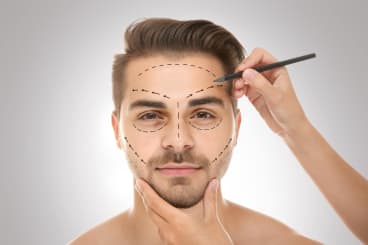 Umbilicoplasty
UmbilicoplastyEverything You Need To Know About Navel Surgery
The belly button is sometimes the last thing we think of when it comes to cosmetic procedures. Navel surgery, however, is an increasingly common and minor procedure that, for the right person, can deliver big results.
The belly button is sometimes the last thing we think of when it comes to cosmetic procedures. Navel surgery, however, is an increasingly common and minor procedure that, for the right person, can deliver big results. The procedure is a great option for patients who are unhappy with either the size or shape of their navel and offers a solution for people who have developed an umbilical hernia (which gives the navel an outward profile). Here’s what you need to know if you think the procedure is right for you.
What Is an Umbilicoplasty?
Umbilicoplasty, or belly button surgery, is used to reshape the belly button for reasons such as:
- Small umbilical hernias
- Changes in shape that result from pregnancy or weight gain
- Piercing scars
- Asymmetrical shape
- Moving the placement of the navel on the abdomen
The procedure is primarily carried out on women, often following a pregnancy. Patients who turn to plastic surgery to correct a misshapen navel typically do so because they are self-conscious about it and its appearance has a negative effect on their confidence.
The belly button is initially formed after the umbilical cord is clamped and cut after birth. The scar tissue left behind after the umbilical stump falls off leaves babies with a navel, that can either be an ‘innie’ or an ‘outie’ depending on a few factors. Either shape of navel is natural and is not a cause for medical concern, but some people find themselves unhappy with the shape of their navel in later life and decide to have surgery to correct it.
Umbilicoplasty can also be used for patients who have small umbilical hernias that were not treated when they were younger. An umbilical hernia occurs when a small part of the intestine comes through the abdominal wall causing a bulge to appear around the navel. Large umbilical hernias that do not go away on their own by the time a child turns four are generally treated with surgery. But those whose hernias are smaller and do not cause any discomfort may find it still there as an adult, and seek the attention of a cosmetic surgeon to correct its appearance.
Patients who are having the procedure for purely cosmetic reasons often prefer to have the procedure carried out by a plastic surgeon because their main focus is the final appearance of the navel. “A plastic surgeon will be more focused on aesthetics, as opposed to simply fixing the hernia,” explains board certified plastic surgeon Gregory Buford, MD. “They will finesse the area, and can address any other issues including skin bridges from piercings during the process.”
If there is a significant hernia, reshaping could be ineffective and a correction of the hernia should be considered before going ahead with reshaping the navel. Your surgeon should discuss with you what the best course of treatment is to achieve the result you are looking for.
How Does An Umbilicoplasty Work?
After the initial consultation, umbilicoplasty can be carried out in the surgeon’s office if they are performing the procedure under local anesthesia or in an operating room if you are having the procedure under general anesthesia. The surgeon will remove the extra skin surrounding the navel and will line up the remaining skin to give the area a neat appearance. They can also alter the height of the navel on your stomach. Once the surgeon is happy with the appearance and placement of the new navel, they will stitch the incision back together. The procedure itself takes under an hour, and if it is performed under local anesthesia you will likely be able to return home on the same day.
While some patients seek out cosmetic surgery specifically for their navel, others commonly ask for it to be added to a larger treatment plan. “It is not uncommon for breast surgery patients to have their navel fixed at the same time and it can be performed alongside other procedures too,” says Dr. Buford.
Umbilicoplasty Recovery and Side Effects
The surgery can cause minor discomfort in the days following the procedure, but most patients are able to get back to their daily activities within a few days. More strenuous activities such as exercising should be avoided for up to two weeks. Your surgeon will be able to advise you as to specific restrictions depending on your lifestyle.
It is important to keep the area clean after surgery, and you will be given waterproof bandages to protect the incision from water when you wash until the stitches have either dissolved or been removed depending on the type used. If you have traditional stitches they will be removed around a week after surgery. There will be a small scar after the procedure, which is usually hidden inside the new navel, and it will fade over time.
There are a few risks associated with having an umbilicoplasty, such as those associated with anesthesia. There is also the risk of infection following surgery, and you should think about the scar itself. Your surgeon will do their best to hide it, but there is a risk that it will be visible after the procedure. The risk of an asymmetric result should also be kept in mind. Your surgeon will work to provide a realistic expectation of the result and make sure to ask questions about asymmetry in your consultation.
Related Procedures

AI Plastic Surgeon™
powered by'Try on' aesthetic procedures and instantly visualize possible results with The AI Plastic Surgeon, our patented 3D aesthetic simulator.

